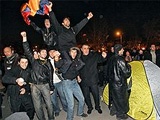|
|
TODAY.AZ / Politics
Armenian police forcibly halt election protests
01 March 2008 [12:05] - TODAY.AZ
 Armenian riot police used truncheons Saturday to break up a 10-day protest in the capital Yerevan by opposition supporters who say last month’s presidential election was rigged, witnesses said.
Armenian riot police used truncheons Saturday to break up a 10-day protest in the capital Yerevan by opposition supporters who say last month’s presidential election was rigged, witnesses said.Several thousand opposition supporters had been protesting daily in Yerevan’s Freedom Square since Prime Minister Serzh Sarksyan was elected to replace his ally Robert Kocharyan as president in a Feb. 19 vote.
The riot police moved into the square early on Saturday after authorities had said they were losing patience with the protests, led by Levon Ter-Petrosyan, Armenia’s first president after independence from the Soviet Union.
“We were asleep,” said one of the protesters who had been keeping an overnight vigil in the square.
“They came and they started to beat us up. They had truncheons,” said the man, who showed Reuters a broken finger. He declined to give his name.
The protests had risked destabilizing Armenia, a former Soviet republic that lies in a Caucasus mountains region now emerging as an important transit route for oil and gas supplies from the Caspian Sea to world markets.
Armenia is still officially at war with neighboring Azerbaijan over the territory of Nagorno-Karabakh. Oil and gas pipelines operated by a BP-led consortium run through Azeri territory a few miles from the conflict zone.
Allegations of a stolen vote
Ter-Petrosyan,
who ran in the election, launched the protests after alleging Sarksyan
had used ballot-stuffing and intimidation to steal victory. Sarksyan
denied the charges, and Western observers have called the vote broadly
fair.
At their peak the protests attracted tens of thousands of people, though numbers had fallen off in the past few days.
A spokesman for Ter-Petrosyan said riot police moved in at 7.30 a.m. Saturday (10:30 p.m. ET Friday). “They came, they beat people up and they removed everyone,” said Arman Musinyan.
Ter-Petrosyan was not detained and had returned home, he said, adding the opposition planned to attempt a further protest later on Saturday.
But a Reuters correspondent at Freedom Square said it was now surrounded by several hundred police with riot shields and that they were not allowing anyone access.
A group of about 15 people began shouting “Levon! Levon!” near the square. Police quickly moved in to disperse them, the correspondent said.
Observers from the Organization for Security and Cooperation in Europe said the Feb. 19 election broadly met Armenia’s commitments on democracy, though there were some flaws.
/Reuters/URL: http://www.today.az/news/politics/43478.html
 Print version
Print version
Connect with us. Get latest news and updates.
See Also
- 12 September 2025 [01:33]
Evidence of shelling, civilian killings, and hostage-taking presented in court - 11 September 2025 [12:36]
National Assembly backs Washington declaration, bolstering Azerbaijan’s global role - 11 September 2025 [12:12]
And you will be cured! Mikhalkov as a crazy "lightning rod" of Russian propaganda - 11 September 2025 [12:01]
Remains of four fallen soldiers from First Garabagh War to be laid to rest - 11 September 2025 [11:11]
US Congress refused to consider anti-Azerbaijani amendments - the failure of the Armenian lobby in Washington - 11 September 2025 [10:42]
Uzbekistan, Azerbaijan agree to strengthen inter-parliamentary cooperation - 10 September 2025 [14:26]
President Ilham Aliyev attends opening of Samad Vurgun Creativity House of the Writers’ Union - 10 September 2025 [14:00]
Armenian revanchists have found new savior of the nation - 10 September 2025 [10:00]
Hikmet Hajiyev meets U.S. lawmakers to discuss strategic ties - 10 September 2025 [02:04]
Azerbaijan's Foreign Ministry expresses concern over attack in Qatar
Most Popular
 Ambassador Lu Mei: Azerbaijan plays key role in China-Europe railway express
Ambassador Lu Mei: Azerbaijan plays key role in China-Europe railway express
 Hikmet Hajiyev meets U.S. lawmakers to discuss strategic ties
Hikmet Hajiyev meets U.S. lawmakers to discuss strategic ties
 Azerbaijan invites US companies to invest in Middle Corridor opportunities
Azerbaijan invites US companies to invest in Middle Corridor opportunities
 Armenian revanchists have found new savior of the nation
Armenian revanchists have found new savior of the nation
 German shipping companies explore cooperation opportunities in Azerbaijan
German shipping companies explore cooperation opportunities in Azerbaijan
 BRI advances with Azerbaijan’s strategic investment plans at CIFIT 2025
BRI advances with Azerbaijan’s strategic investment plans at CIFIT 2025
 ASCO’s Kalbajar tanker completes four years of service
ASCO’s Kalbajar tanker completes four years of service
